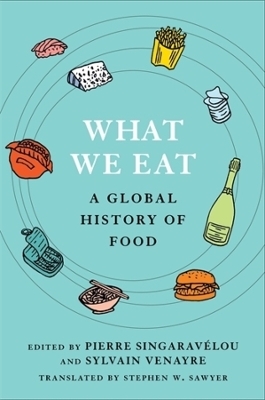
What We Eat
A Global History of Food
Seiten
2025
Columbia University Press (Verlag)
978-0-231-21368-4 (ISBN)
Columbia University Press (Verlag)
978-0-231-21368-4 (ISBN)
- Noch nicht erschienen (ca. März 2025)
- Versandkostenfrei innerhalb Deutschlands
- Auch auf Rechnung
- Verfügbarkeit in der Filiale vor Ort prüfen
- Artikel merken
Ketchup seems iconically American, but the word comes from a Southeast Asian anchovy sauce, and today it is made largely from Chinese tomato paste. Japan’s beloved ramen arose from the meeting of Chinese noodles and American wheat flour before attaining worldwide popularity in both gourmet and convenience-food forms. The baguette is mythologized as a product of the French Revolution, but in fact it emerged during late-nineteenth-century urbanization. Colonialism brought baguettes to Vietnam, where street vendors devised a new dish: banh mi, which refugees took with them around the world.
Telling these tales and many others, What We Eat explores world history through the lens of the global journeys of nearly ninety food products. Leading historians trace the origins and popularization of items commonly found in supermarkets, showing how each food illuminates wider histories. They consider the tension between the role of cuisine in shaping particular cultural identities and the standardization associated with globalization, and they demonstrate how foods have transformed as different societies have borrowed them. Chapters reveal the surprising sagas of coffee, cornflakes, gin, guacamole, hot dogs, hummus, naan, pet food, pizza, sparkling water, sushi, and many more. At once an intimate and a global history, What We Eat shows readers the everyday items on grocery store shelves in a new light.
Telling these tales and many others, What We Eat explores world history through the lens of the global journeys of nearly ninety food products. Leading historians trace the origins and popularization of items commonly found in supermarkets, showing how each food illuminates wider histories. They consider the tension between the role of cuisine in shaping particular cultural identities and the standardization associated with globalization, and they demonstrate how foods have transformed as different societies have borrowed them. Chapters reveal the surprising sagas of coffee, cornflakes, gin, guacamole, hot dogs, hummus, naan, pet food, pizza, sparkling water, sushi, and many more. At once an intimate and a global history, What We Eat shows readers the everyday items on grocery store shelves in a new light.
Pierre Singaravélou is professor of history at Paris 1 Panthéon-Sorbonne University and a former British Academy Global Professor of History at King’s College London. Sylvain Venayre is professor of contemporary history at the University of Grenoble-Alpes. Stephen W. Sawyer is the Ballantine-Leavitt Professor of History and director of the Center for Critical Democracy Studies at the American University of Paris.
| Erscheint lt. Verlag | 25.3.2025 |
|---|---|
| Reihe/Serie | Arts and Traditions of the Table: Perspectives on Culinary History |
| Übersetzer | Stephen W. Sawyer |
| Verlagsort | New York |
| Sprache | englisch |
| Maße | 156 x 235 mm |
| Themenwelt | Sachbuch/Ratgeber ► Essen / Trinken |
| Geisteswissenschaften ► Geschichte ► Allgemeine Geschichte | |
| Geschichte ► Teilgebiete der Geschichte ► Kulturgeschichte | |
| ISBN-10 | 0-231-21368-9 / 0231213689 |
| ISBN-13 | 978-0-231-21368-4 / 9780231213684 |
| Zustand | Neuware |
| Haben Sie eine Frage zum Produkt? |
Mehr entdecken
aus dem Bereich
aus dem Bereich
der stille Abschied vom bäuerlichen Leben in Deutschland
Buch | Hardcover (2023)
C.H.Beck (Verlag)
23,00 €
eine Geschichte der Welt in 99 Obsessionen
Buch | Hardcover (2023)
Klett-Cotta (Verlag)
22,00 €
Titel, Throne, Traditionen
Buch | Softcover (2023)
C.H.Beck (Verlag)
19,95 €


